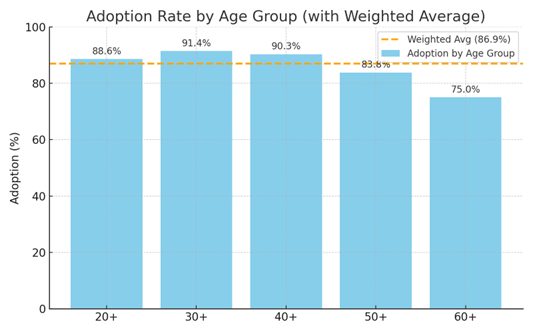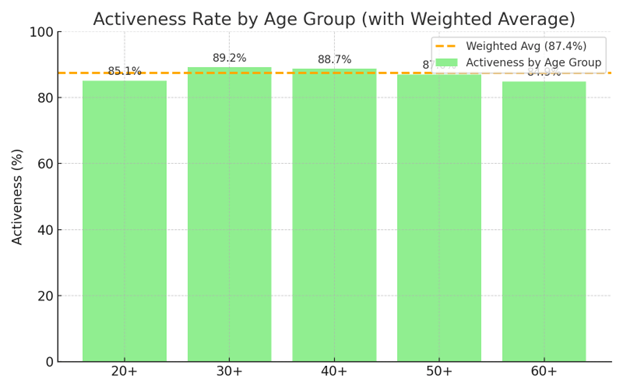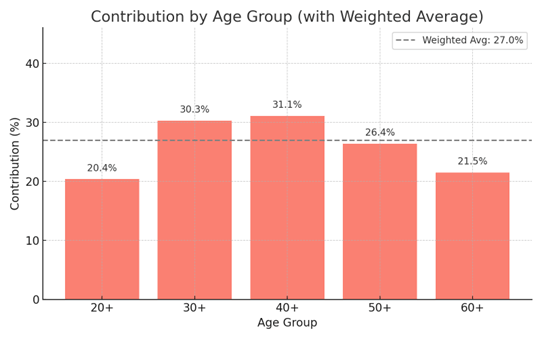In today’s multigenerational workplace, digital tools like employee communication platforms are vital connectors. Yet not every age group interacts with these platforms in the same way. Understanding these differences is crucial for HR professionals aiming to build inclusive and engaging digital experiences. At GuavaHR, we took a deep dive into usage data to analyze how age impacts three key engagement metrics: Adoption, Activeness, and Contribution.
By examining aggregated and anonymized usage data across a diverse user base, we discovered compelling patterns in how employees from their 20s to their 60s embrace digital internal communication. Whether you’re planning your next internal rollout or rethinking your onboarding strategy, these insights can help ensure your employee app delivers value to all age groups.
Adoption: Who needs help in the Starting Line?
Adoption is the first hurdle: it measures how many invited employees actually start using the app. In our data, employees aged 20 to 49 led the way with adoption rates around 90%. These age groups often combine digital familiarity with strong workplace involvement. They’re generally comfortable using modern apps and also have growing responsibilities within their teams, which makes them more likely to adopt and engage with internal platforms.

However, adoption declines among older age groups. Employees aged 50+ dropped to 83.8%, still decent, but those over 60 saw adoption fall to just 75%. These numbers point to real digital friction. Older employees may face challenges ranging from unfamiliar interfaces to lack of training or confidence using new platforms.
To bridge this gap, companies can invest in dedicated onboarding for older age groups. Think tech-buddy systems, printed how-to guides, or personalized coaching sessions during their first weeks. Adoption is the foundation for all other engagement—get this right, and you have smoother ride in the future.
Activeness: Staying Engaged Once Onboarded
Once employees join the platform, the next challenge is keeping them active. Activeness is defined as the proportion of users who regularly (monthly/weekly) engage with the app. What’s striking is the consistency of this metric across age groups. Even users aged 60+ maintain an activeness rate of nearly 85%, showing that once initial barriers are overcome, digital participation remains strong regardless of age.

Maintaining high levels of engagement depends heavily on the early user experience. When employees find immediate value—such as upcoming events, important deadlines, or relevant HR announcements—they’re more likely to return regularly. But it’s not just about delivering content—it’s about how easily users can access and interact with it. A simple, intuitive interface paired with fresh, timely information is key to turning first-time users into active participants. If the platform feels complicated or the content outdated, even motivated users can disengage. That’s why HR teams should focus on usability and ensure that the news feed remains dynamic and relevant. Smart use of push notifications, short, guided onboarding experiences that help users quickly find value, and personalized content can make all the difference in sustaining engagement from day one.
Contribution: Who’s Creating Content?
Contribution reflects how many users go beyond passive reading—those who like, comment, or create content. This includes lightweight interactions such as reacting to a post or replying with an emoji, making it a strong indicator of emotional and social engagement.
Interestingly, our analysis shows that employees in their 30s and 40s are the most engaged contributors, with over 30% showing active participation. These users are not just consuming information; they’re part of the conversation.

Meanwhile, users in their 20s—often digital natives—have lower contribution rates (around 20%). This may reflect a sense of hesitation in formal workplace settings, or uncertainty about the relevance of their voice. For older users, contribution also dips, possibly due to unfamiliarity with newer engagement norms.
To improve contribution across the board, HR teams should normalize small actions—liking a post, responding to updates, and giving kudos. These lightweight gestures help reinforce a culture of appreciation and participation.
Final Thoughts
Segmenting employee app usage by age delivers practical insights for digital workplace strategy. Younger employees need encouragement to contribute. Older employees need support to adopt. Mid-career professionals? They’re your champions—empowered, motivated, and willing to lead by example.
These patterns aren’t just data points. They’re windows into how employees relate to your culture, how connected they feel, and whether they feel heard. Tailoring your communication strategy to reflect these generational dynamics ensures you’re building a truly inclusive digital culture.
At GuavaHR, we continue to develop tools and insights to help companies engage every generation in the workplace. If you’d like to audit or get help tailoring your internal communication delivery, our team is just a click away.




